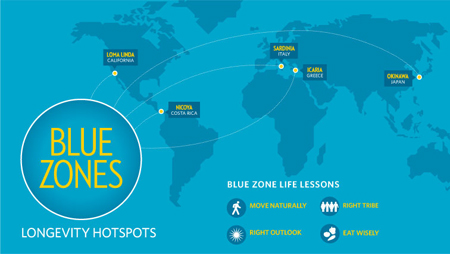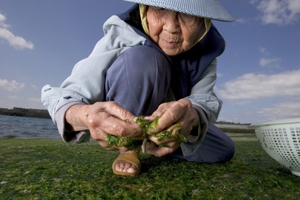Seems nearly every day new reports about aging and how to slow or reverse the process hit the airwaves. As Americans, we seem to be obsessed with staying young, however, it seems we’re not going about it the right way. National Geographic writer and explorer Dan Buettner recently gave a TED talk regarding longevity and who in the world is aging the best.
Buettner refers to the areas of the world with the healthiest and oldest people as Blue Zones. In these zones he has found commonalities that link these cultures and their longevity. One myth Buettner’s studies dispel is that longevity is genetic. Buettner explains that only 10% of how long we live is dictated by our genes, the other 90% is dictated by our lifestyle. Furthermore, Buettner debunks the ideas that effort will allow one to live past 100 and that treatments exist that can slow the aging process. After observing the Blue Zones, it’s clear that lifestyle is key to the aging process.

Buettner focused on just three of the Blue Zones to draw longevity links. The spry 100 year-old men of Sardinia, Italy, the healthy great-great-great-grandmother in Okinawa, Japan, and the American Seventh Day Adventists in California that live nearly ten more years than their fellow Americans all have four common lifestyle traits that lead to their longevity.
The first trait found among these groups is that they move naturally. Buettner specifically pointed out that they do not exercise, but that they have set up their lives where activity is a constant. The Sardinians live in vertical homes and climb steps daily and many are shepherds walking and climbing the fields. The women in Okinawa sit on the floor and get up and down nearly 40 times a day. The Seventh Day Adventists do manual labor and take nature walks. These are just a few of the natural acts these cultures do daily; they take no conveniences and manually do most tasks in life.
The second trait Buettner found is that those in the Blue Zones have the right outlook. All the cultures take a time to downshift. The Adventists take a 24-hour Sabbath every week, no matter what. In addition to downshifting, these cultures have a sense of purpose. Whether it’s the faith they follow or their devotion to their life purpose, these cultures live for a reason.
The third trait is that these people eat wisely. The cultures primarily have a plant-based diet, they drink red wine daily, and they have means to avoid overeating.
Finally, the people in the Blue Zones connect. All of these cultures put loved ones first and place high value on their elders. They don’t live alone and live life among other people. They may belong to a faith-based community or even a “tribe.” These cultures proactively seek out the right people to live their lives with.
No pills, no treadmills, no “diets”, or self-help books are found in these cultures. Those who live the longest in our world have been doing so with the technology and ideals of their ancestors. Buettner’s research really challenges all of our society’s beliefs of how to live a long healthy life.
map image via AARP; woman via bluezones.com
